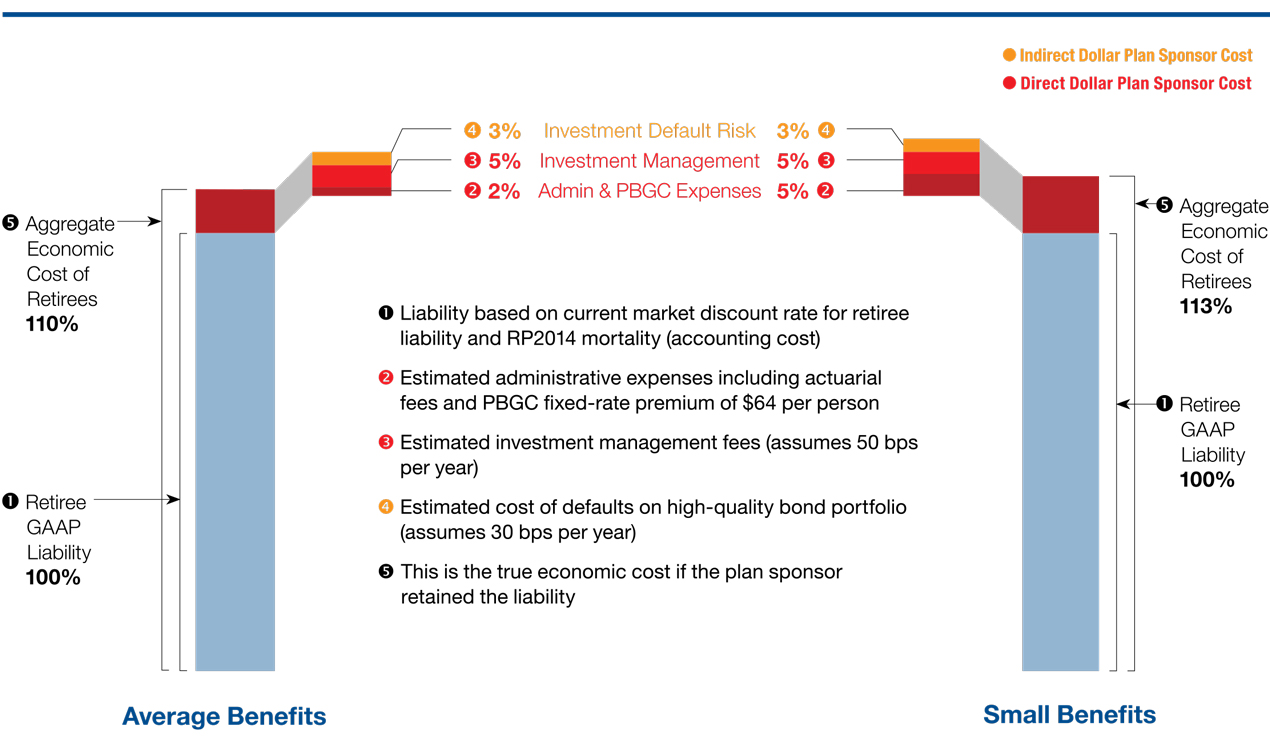The High Economic Cost of Small Pension Benefits
 Russ Proctor (left) and Marty Menin
Russ Proctor (left) and Marty Menin
Photography by Michael Justice
In 2013 and 2014, approximately $4 billion and $9 billion, respectively, of pension liabilities were transferred to insurance companies by sponsors of defined benefit (DB) pension plans. The first quarter of 2015 likewise saw more than $3 billion transacted in the first two months. To further discuss these ongoing trends in the pension risk transfer (PRT) market, Alison Cooke Mintzer, editor-in-chief of PLANSPONSOR, spoke with Russ Proctor and Marty Menin, both directors of institutional sales at Pacific Life. Here they continue their conversation, which started with last year’s “Economic Cost vs. Accounting Cost” interview, now going into greater detail to explore the plan sponsor’s economic cost for smaller pension benefits.
PS: What has changed in our pension de-risking market here in the U.S. since last year?
Proctor: There have been significant changes since we spoke to PLANSPONSOR last September. You mentioned the large increase in risk transfer annuity sales. In the fourth quarter of 2014, there were $7 billion in sales, and already in the first quarter of 2015 about $3 billion. Some of these transactions are focused on retirees with smaller benefits, indicating to us that plan sponsors understand the annuity cost may now be lower than the cost of maintaining these liabilities.
Also, the Society of Actuaries (SOA)’s new mortality table was released in October. Many plan sponsors adopted the new table for their 2014 year-end pension liability, increasing that liability by 4% to 10%, depending on the plan. The annuity pricing used by insurance companies already included the improving mortality, so it didn’t affect the annuity pricing. Now the liability on plan sponsors’ balance sheets is closer to the cost of an equivalent annuity provided by an insurance company.
PS: Tell me, how do you define “smaller benefits”?
Menin: Roughly around $200 to $300 per month, but the amount will be different for every company because each has a different expense structure. We often encourage plan sponsors to look at their population, evaluate their expenses and fees, and determine the right level for their plan. Our analysis found that for benefits less than $300 per month, expenses typically outweigh the price of an annuity.
PS: Plan sponsors have also been telling us how the increased expenses are negatively affecting their DB plans. Is it really that bad?
Proctor: It is, particularly for smaller benefits. For example, our chart shows an administrative expense of about 2% of the total retired liability for a typical plan. However, the “per participant” Pension Benefit Guarantee Corporation (PBGC) premiums have a larger percentage impact on the smaller pension benefits. PBGC premiums are now $57 per participant and will rise to $64 next year. For an average benefit, let’s say a retiree paid $2,000 a month, the administrative cost for that total annual PBGC premium is about 0.27%. But for the smaller benefits—for example, a retiree paid $200 a month—that’s an annual cost of 2.7%. Thus, the total administrative expense of 2% for the typical retiree liability would increase to 5% for retirees with small benefits.
When you add in the investment management fees and investment risks—defaults and downgrades, etc.—the total economic cost for smaller pension benefits can easily reach 113% of the accounting liability.
The annuity cost for these small benefits may be only 105% of the accounting liability. Thus, a plan sponsor may find that the price to buy annuities for these retirees is considerably less than the total economic cost of maintaining those liabilities in the plan, as estimated at 113% in the example above.

PS: Is this a problem for all plan sponsors? Does industry make a difference?
Menin: This is true for many plan sponsors because not all of their employees participate in the pension plan for a full career. Even companies with highly paid salaried employees are likely to have a subset of retirees who are vested in a small pension benefit, having worked at the company only a few years before moving on to another company.
There are also industries, such as the retail industry, that typically have a lower-paid, higher-turnover work force. These plan sponsors will naturally accumulate even more small retirement benefit liabilities. Retailers with defined benefit plans typically have lower average benefits and thus a higher average expense ratio.
PS: So you’re saying plan sponsors can segment out this set of smaller liabilities to an insurance company, and that buying an annuity can reduce expenses while still keeping the plan active?
Menin: Yes, absolutely. This is one of the most common forms of risk transfer we see today. A plan sponsor can demonstrate to its board of directors that the economic cost of these smaller pension benefits is more expensive than the annuity cost, even in this low-interest-rate environment.
PS: How do plan sponsors know whether this is the right option for them?
Proctor: We encourage plan sponsors to talk to their pension consultants and their advisers and ask for help analyzing the expense structure of their plan. In our example above, we show the impact of investment management fees, assuming 50 basis points (bps) per year, creating a 5% economic cost. This can vary widely, so each plan sponsor needs to determine what it actually pays, to pinpoint the true economic cost for the plan. We also show an increase, from 2% to 5%, for the economic cost of administrative and PBGC expenses for small benefits. Adding a default risk cost of approximately 3% gives us a total economic cost of 113%.
The point is plan sponsors can get an annuity quote and compare that against their economic cost to decide if the annuity purchase would make sense for them. They can then determine where their break-even point is for these small benefits, and decide which benefits they should buy out based on this detailed economic cost analysis.
Pacific Life Insurance Company is not affiliated with PLANSPONSOR.
